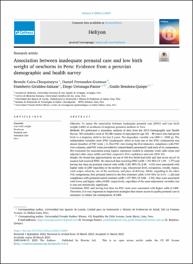Mostrar el registro sencillo del ítem
Association between inadequate prenatal care and low birth weight of newborns in Peru: Evidence from a peruvian demographic and health survey
| dc.contributor.author | Caira-Chuquineyra, Brenda | |
| dc.contributor.author | Fernandez-Guzman, Daniel | |
| dc.contributor.author | Giraldez-Salazar, Humberto | |
| dc.contributor.author | Urrunaga-Pastor, Diego | |
| dc.contributor.author | Bendezu-Quispe, Guido | |
| dc.date.accessioned | 2023-09-21T14:36:56Z | |
| dc.date.available | 2023-09-21T14:36:56Z | |
| dc.date.issued | 2023-03-20 | |
| dc.identifier.uri | https://hdl.handle.net/20.500.13053/9410 | |
| dc.description.abstract | “Objective To assess the association between inadequate prenatal care (IPNC) and Low birth weight (LBW) in newborns of singleton gestation mothers in Peru. Methods We performed a secondary analysis of data from the 2019 Demographic and Health Survey. We included a total of 10,186 women of reproductive age (15 – 49 years) who had given birth to a singleton child in the last 5 years. The dependent variable was LBW (< 2500 g). The independent variables were IPNC (inadequate: when at least one of the IPNC components was absent [number of PNC visits ≥ 6, first PNC visit during the first trimester, compliance with PNC visit contents, and PNC visits provided by trained health personnel]) and each of its components. We evaluated the association using logistic regression models to estimate crude odds ratios and adjusted odds ratios (aOR) and their respective 95% confidence intervals (95% CI). Results We found that approximately six out of 100 live births had LBW and that seven out of 10 women had received IPNC. We observed that receiving IPNC (aOR: 1.39; 95% CI: 1.09 – 1.77) and having less than six prenatal control visits (aOR: 3.20; 95% CI: 2.48 – 4.13) were associated with higher odds of LBW regardless of the mother's age, educational level, occupation, wealth, region, rural origin, ethnicity, sex of the newborns, and place of delivery. While, regarding to the other PNC components, first prenatal control in the first trimester (aOR: 0.99; 95% CI: 0.76 – 1.28) and compliance with prenatal control contents (aOR: 1.07; 95% CI: 0.86 – 1.34), they were associated with lower and higher odds of LBW, respectively, regardless of the same adjustment variables, but it was not statistically significant. Conclusions IPNC and having less than six PNC visits were associated with higher odds of LBW. Therefore, it is very important to implement strategies that ensure access to quality prenatal care is necessary to reduce the consequences of LBW.“ | es_PE |
| dc.format | application/pdf | es_PE |
| dc.language.iso | eng | es_PE |
| dc.publisher | Elsevier Ltd | es_PE |
| dc.rights | info:eu-repo/semantics/openAccess | es_PE |
| dc.rights.uri | https://creativecommons.org/licenses/by/4.0/ | es_PE |
| dc.subject | "Low birth weight Newborns Prenatal care Antenatal care Peru" | es_PE |
| dc.title | Association between inadequate prenatal care and low birth weight of newborns in Peru: Evidence from a peruvian demographic and health survey | es_PE |
| dc.type | info:eu-repo/semantics/article | es_PE |
| dc.identifier.doi | 10.1016/j.heliyon.2023.e14667 | |
| dc.type.version | info:eu-repo/semantics/publishedVersion | es_PE |
| dc.publisher.country | NL | es_PE |
| dc.subject.ocde | 3.00.00 -- Ciencias médicas, Ciencias de la salud | es_PE |
Ficheros en el ítem
Este ítem aparece en la(s) siguiente(s) colección(es)
-
Web of Science (WOS) [236]


